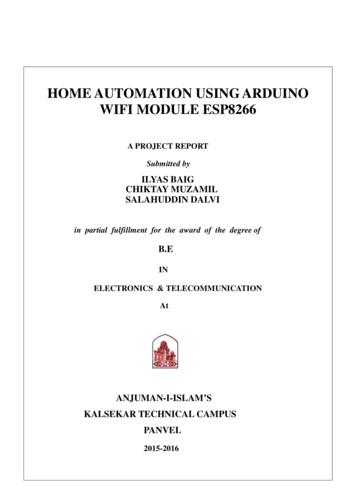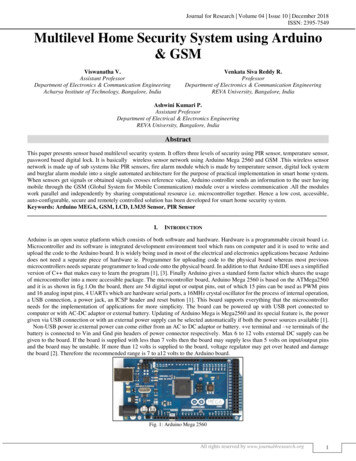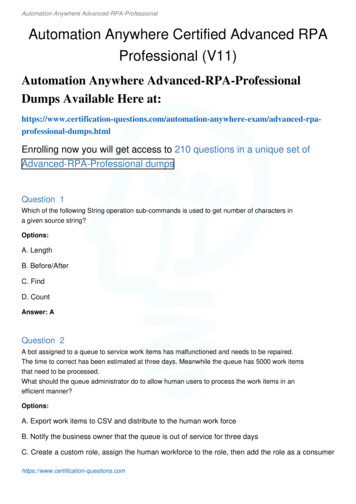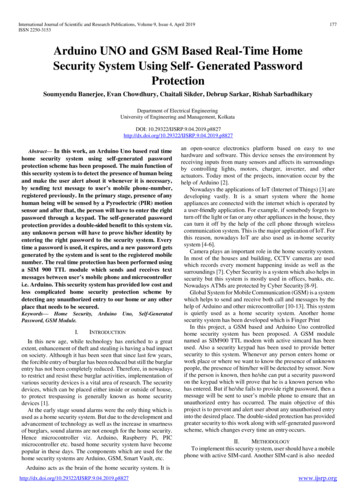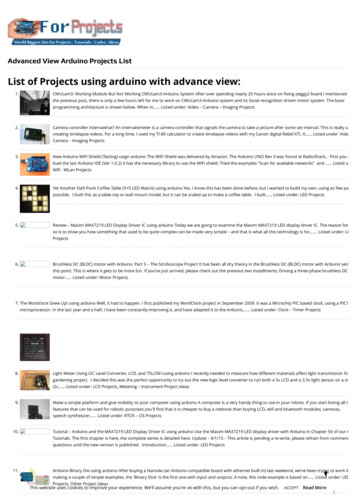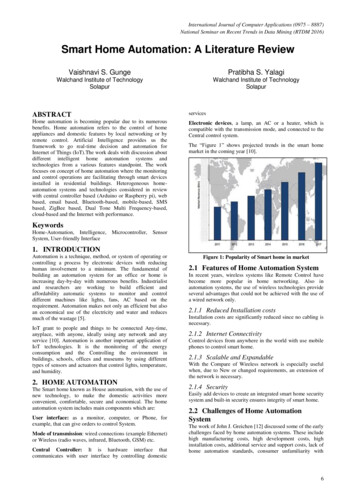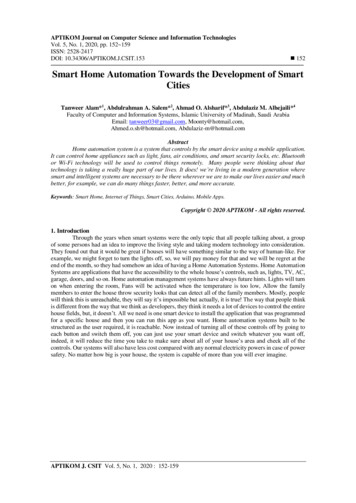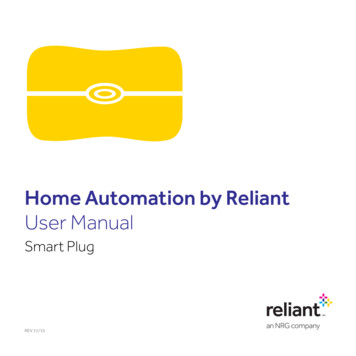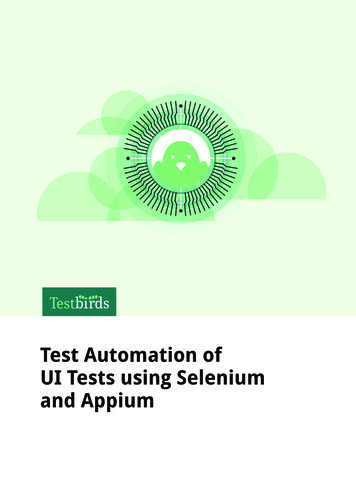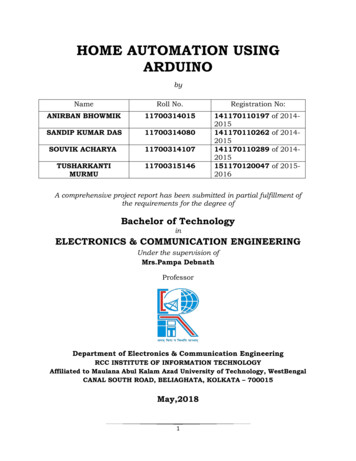
Transcription
HOME AUTOMATION USINGARDUINObyNameRoll No.ANIRBAN BHOWMIK11700314015SANDIP KUMAR DAS11700314080SOUVIK tration 51511701200472016of 2014of 2014of 2014of 2015-A comprehensive project report has been submitted in partial fulfillment ofthe requirements for the degree ofBachelor of TechnologyinELECTRONICS & COMMUNICATION ENGINEERINGUnder the supervision ofMrs.Pampa DebnathProfessorDepartment of Electronics & Communication EngineeringRCC INSTITUTE OF INFORMATION TECHNOLOGYAffiliated to Maulana Abul Kalam Azad University of Technology, WestBengalCANAL SOUTH ROAD, BELIAGHATA, KOLKATA – 700015May,20181
CERTIFICATE OF APPROVALThis is to certify that the project titled HOME AUTOMATION SYSTEM USINGARDUINO carried out byNameRoll No.Registration No:ANIRBAN BHOWMIKSANDIP KUMAR DASSOUVIK ACHARYATUSHARKANTI 41170110197 of 2014- 2015141170110262 of 2014-2015141170110289 of 2014-2015151170120047 of 2015-2016for the partial fulfillment of the requirements for B.Tech degree in Electronics andCommunication Engineering from Maulana Abul Kalam Azad University ofTechnology, West Bengalis absolutely based on his own work under the supervision ofMrs. Pampa Debnath. The contents of this thesis, in full or in parts, have not beensubmitted to any other Institute or University for the award of any degree or diploma.Optional in case of External Supervisor.Dr./Mr./Ms./Mrs.Designation and DepartmentInstitute.Dr./Mr./Ms./Mrs.Professor , Dept. of ECERCC Institute of Information Technology.Dr. Abhishek BasuHead of the Department (ECE)RCC Institute of Information Technology2
DECLARATION‚We Do hereby declare that this submission is our own work conformed to thenorms and guidelines given in the Ethical Code of Conduct of the Institute and that, tothe best of our knowledge and belief, it contains no material previously written byanother neither person nor material (data, theoretical analysis, figures, and text) whichhas been accepted for the award of any other degree or diploma of the university orother institute of higher learning, except where due acknowledgement has been madein the text.‛.Anirban BhowmikSandip Kumar DasRegistration No:141170110197 OF 2014-2015Roll No: 11700314015Registration No:141170110262 OF 2014-2015Roll No:11700314080.Souvik AcharyaTusharkanti MurmuRegistration No:141170110289 OF 2014-2015Roll No: 11700314107Registration No:151170120047 OF 2015-2016Roll No: 11700315146Date:Place:3
CERTIFICATE of ACCEPTANCEThis is to certify that the project titled HOME AUTOMATION SYSTEM USINGARDUINO carried out byNameRoll No.ANIRBAN BHOWMIK11700314015SANDIP KUMAR DAS11700314080SOUVIK tration 51511701200472016of 2014of 2014of 2014of 2015-is hereby recommended to be accepted for the partial fulfillment of the requirements forB.Tech degree in Electronics and Communication Engineering from Maulana Abul KalamAzad University of Technology, West BengalName of the Examiner Signature with Date1. 2. . .3. 4. . 4
ABSTRACTThe main objective of this project is to develop a home automation system using an Arduinoboard with Bluetooth being remotely controlled by any Android OS smart phone. Astechnology is advancing so houses are also getting smarter. Modern houses are graduallyshifting from conventional switches to centralized control system, involving remote controlledswitches. Presently, conventional wall switches located in different parts of the house makes itdifficult for the user to go near them to operate. Even more it becomes more difficult for theelderly or physically handicapped people to do so. Remote controlled home automation systemprovides a most modern solution with smart phones. In order to achieve this, a Bluetoothmodule is interfaced to the Arduino board at the receiver end while on the transmitter end, aGUI application on the cell phone sends ON/OFF commands to the receiver where loads areconnected. By touching the specified location on the GUI, the loads can be turned ON/OFFremotely through this technology. The loads are operated by Arduino board through optoisolators and thyristors using triacs.5
CONTENTSCERTIFICATE .1DECLARATION .2CERTIFICATE of ACCEPTANCE . .3ABSTRACT 5CONTENTS .6LIST OF FIGURES 7INTRODUCTION .8COMPONENTS REQUIRED .9DESCRIPTION .10BLOCK DIAGRAM 40CIRCUIT DIAGRAM .41CODE .42APPLICATION .45CONCLUSION .48REFERENCE .496
LIST OF FIGURESFIG 1ARDUINO UNO R3PAGE 12FIG 22 CHANNEL RELAYPAGE 30FIG 32 CHANNEL RELAYPAGE 33FIG 4BLUETOOTH MODULEPAGE 36FIG 5PIN DESCRIPTION OF BLUETOOTH MODULEPAGE 36FIG 6BLOCK DIAGRAMPAGE 39FIG 7CIRCUIT DIAGRAMPAGE 407
INTRODUCTIONNowadays, we have remote controls for our television sets and other electronic systems, whichhave made our lives real easy. Have you ever wondered about home automation which wouldgive the facility of controlling tube lights, fans and other electrical appliances at home using aremote control? Off-course, Yes! But, are the available options cost-effective? If the answer isNo, we have found a solution to it. We have come up with a new system called Arduino basedhome automation using Bluetooth. This system is super-cost effective and can give the user, theability to control any electronic device without even spending for a remote control. This projecthelps the user to control all the electronic devices using his/her smartphone. Time is a veryvaluable thing. Everybody wants to save time as much as they can. New technologies are beingintroduced to save our time. To save people’s time we are introducing Home Automationsystem using Bluetooth . With the help of this system you can control your home appliancesfrom your mobile phone. You can turn on/off your home appliances within the range ofBluetooth.8
COMPONENTS REQUIRED1)ARDUINO UNO2)2 CHANNEL RELAY(5v)3)BLUETOOTH MODULE HC054)POWER SUPPLY5)LOAD(BULB 220V)6)CONNECTING WIRES7)VERO BOARD8)SMARTPHONE(BLUETOOTH ENABLED)9
DESCRIPTIONARDUINO UNOArduino is an open source computer hardware and software company, project, and usercommunity that designs and manufactures single-boardmicrocontrollers and microcontroller kits for building digital devices and interactive objects thatcan sense and control objects in the physical and digital world. The project's products aredistributed as open-source hardware and software, which are licensed under the GNU LesserGeneral Public License (LGPL) or the GNU General Public License (GPL), permitting themanufacture of Arduino boards and software distribution by anyone. Arduino boards areavailable commercially in preassembled form, or as do-it-yourself (DIY) kits.Arduino board designs use a variety of microprocessors and controllers. The boards areequipped with sets of digital and analog input/output (I/O) pins that may be interfaced tovarious expansion boards or Breadboards (shields) and other circuits. The boards feature serialcommunications interfaces, including Universal Serial Bus (USB) on some models, which arealso used for loading programs from personal computers. The microcontrollers are typicallyprogrammed using a dialect of features from the programming languages C and C . Inaddition to using traditional compiler toolchains, the Arduino project provides an integrateddevelopment environment (IDE) based on the Processing language project.The Arduino project started in 2003 as a program for students at the Interaction Design InstituteIvrea in Ivrea, Italy, aiming to provide a low-cost and easy way for novices and professionals tocreate devices that interact with their environment using sensors and actuators. Commonexamples of such devices intended for beginner hobbyists include simple robots, thermostats,and motion detectors.10
The name Arduino comes from a bar in Ivrea, Italy, where some of the founders of the projectused to meet. The bar was named after Arduin of Ivrea, who was the margrave of the March ofIvrea and King of Italy from 1002 to 1014.Features of the Arduino UNO:Microcontroller: ATmega328Operating Voltage: 5VInput Voltage (recommended): 7-12VInput Voltage (limits): 6-20VDigital I/O Pins: 14 (of which 6 provide PWM output)Analog Input Pins: 6DC Current per I/O Pin: 40 mADC Current for 3.3V Pin: 50 mAFlash Memory: 32 KB of which 0.5 KB used by bootloaderSRAM: 2 KB (ATmega328)EEPROM: 1 KB (ATmega328)Clock Speed: 16 MHz11
FIG 1 ARDUINO UNO R312
ARDUINO HARDWARE PART:-Arduino is open-source hardware. The hardware reference designs are distributed undera Creative Commons Attribution Share-Alike 2.5 license and are available on the Arduinowebsite. Layout and production files for some versions of the hardware are also available.Although the hardware and software designs are freely available under copyleft licenses, thedevelopers have requested the name Arduinoto be exclusive to the official product and not beused for derived works without permission. The official policy document on use of the Arduinoname emphasizes that the project is open to incorporating work by others into the officialproduct. Several Arduino-compatible products commercially released have avoided the projectname by using various names ending in -duino.Most Arduino boards consist of an Atmel 8-bitAVR microcontroller (ATmega8, ATmega168, ATmega328, ATmega1280, ATmega2560) withvarying amounts of flash memory, pins, and features. The 32-bit Arduino Due, based on theAtmel SAM3X8E was introduced in 2012. The boards use single or double-row pins or femaleheaders that facilitate connections for programming and incorporation into other circuits. Thesemay connect with add-on modules termed shields. Multiple and possibly stacked shields may beindividually addressable via an I²C serial bus. Most boards include a 5 V linear regulator and a16 MHz crystal oscillator or ceramic resonator. Some designs, such as the LilyPad, run at 8 MHzand dispense with the onboard voltage regulator due to specific form-factor restrictions.Arduino microcontrollers are pre-programmed with a boot loader that simplifies uploading ofprograms to the on-chip flash memory. The default bootloader of the Arduino UNO is theoptiboot bootloader. Boards are loaded with program code via a serial connection to anothercomputer. Some serial Arduino boards contain a level shifter circuit to convert between RS232 logic levels and transistor–transistor logic(TTL) level signals. Current Arduino boards areprogrammed via Universal Serial Bus (USB), implemented using USB-to-serial adapter chipssuch as the FTDI FT232. Some boards, such as later-model Uno boards, substitute the FTDI chipwith a separate AVR chip containing USB-to-serial firmware, which is reprogrammable via itsown ICSP header. Other variants, such as the Arduino Mini and the unofficial Boarduino, use adetachable USB-to-serial adapter board or cable, Bluetooth or other methods. When used with13
traditional microcontroller tools, instead of the Arduino IDE, standard AVR in-systemprogramming (ISP) programming is used.The Arduino board exposes most of the microcontroller's I/O pins for use by other circuits.The Diecimila, Duemilanove, and current Uno provide 14 digital I/O pins, six of which canproduce pulse-width modulated signals, and six analog inputs, which can also be used as sixdigital I/O pins. These pins are on the top of the board, via female 0.1-inch (2.54 mm) headers.Several plug-in application shields are also commercially available. The Arduino Nano, andArduino-compatible Bare Bones Board and Boarduino boards may provide male header pins onthe underside of the board that can plug into solderless breadboards.Many Arduino-compatible and Arduino-derived boards exist. Some are functionally equivalentto an Arduino and can be used interchangeably. Many enhance the basic Arduino by addingoutput drivers, often for use in school-level education, to simplify making buggies and smallrobots. Others are electrically equivalent but change the form factor, sometimes retainingcompatibility with shields, sometimes not. Some variants use different processors, of varyingcompatibility.14
ARDUINO SOFTWARE PART:-IDEThe Arduino integrated development environment (IDE) is a cross-platform application(for Windows, macOS, Linux) that is written in the programming language Java. It originatedfrom the IDE for the languages Processing and Wiring. It includes a code editor with featuressuch as text cutting and pasting, searching and replacing text, automatic indenting, bracematching, and syntax highlighting, and provides simple one-click mechanisms to compile andupload programs to an Arduino board. It also contains a message area, a text console, a toolbarwith buttons for common functions and a hierarchy of operation menus. The source code for theIDE is released under the GNU General Public License, version 2.The Arduino IDE supports the languages C and C using special rules of code structuring. TheArduino IDE s
No, we have found a solution to it. We have come up with a new system called Arduino based home automation using Bluetooth. This system is super-cost effective and can give the user, the ability to control any electronic device without even spending for a remote control. This project helps the user to control all the electronic devices using his/her smartphone. Time is a very valuable thing .
